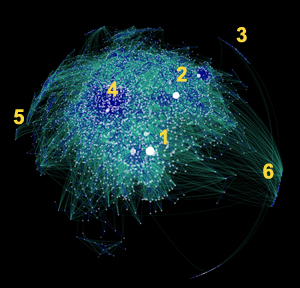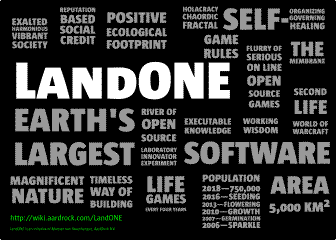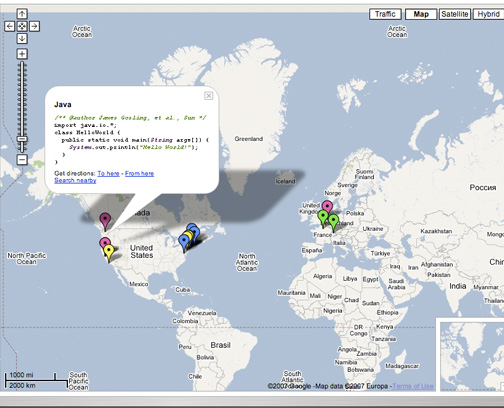Nice summary W3C Semantic Web Frequently Asked Questions.
Category: english

From Discover Magazine:
:The blogosphere is the most explosive social network you’ll never see. Recent studies suggest that nearly 60 million blogs exist online, and about 175,000 more crop up daily (that’s about 2 every second). Even though the vast majority of blogs are either abandoned or isolated, many bloggers like to link to other Web sites. These links allow analysts to track trends in blogs and identify the most popular topics of data exchange. Social media expert Matthew Hurst recently collected link data for six weeks and produced this plot of the most active and interconnected parts of the blogosphere.
Creating a ”’brand new country”’ is a startling endeavour. And today is Earth Day. An excellent day to go public with my passion. I’m giving it my whole heart, soul, and mind.
Previously code-named [http://wiki.aardrock.com/LandONE LandONE], I’ve renamed it to ”’Aarde”’. I’ve started the [http://aardsource.org/ Aarde blog]—domainnames aarde.org and aarde.net are already taken, so I’ve opted for ”’AardSource”’ as name space—an inexhaustable and ever abundant well for everything Aarde. A Wiki for global collaboration will follow soon.
Some ask me, why the name ‘Aarde’? It’s really quite simple. Jeff Bezos, founder of Amazon was once asked how he came up with the name ”’Amazon”’. “Well, it’s the largest river on Earth and it starts with an A.”. (the latter having an excellent free marketing value—you’re always near the top of alphabetical lists). I’ve never forgotten his answer.
In the same spirit ”’Aarde”’:
*is the largest planet around that has life on it (as far as we know);
*starts with a double A;
*has a Dutch connection—my home country.
[http://martien.van.steenbergen.nl/love/ Love],
:Martien.


Sunday April 22 is Earth Day. An important day for AardRock and AardSource as well. A day to remember and mark in my calendar.
The Math of Text Readability

The Math of Text Readability: “An anonymous reader writes ‘Wired magazine has an article that explains The Law of Optical Volumes, a formula for spacing the letters on a printed page that results in maximum readability. Wired’s new logo (did anyone notice?) obeys the law. Unfortunately, Web fonts don’t allow custom kerning pairs, so you can’t work the same magic online as in print. Could this be why some people still prefer newspapers and magazines to the Web?
From Underwire‘s article “Law of Optical Volumes: The Math Behind Wired’s New Logo“:
:”’The same goes for Wired’s new logo”’. It alternates between letters without and with serifs, yet the area between each pair of letters is about the same, thanks to the serifs on the I and E and lack thereof on the W, R and D. This equivalence makes the logo easier to see and read across a crowded supermarket aisle. The alternating fonts also make the letters seem to blink on and off as you read them from left to right, in emulation of digital ones and zeroes.
The story also refers to typography guru Jonathan Hoefler. You can see Hoefler’s work at typography.com.
Read more of this story at Slashdot.
(Via Slashdot.)
Slashdot writes: Second Life To Open Source Server Code. This is an ”’excellent step! And ”’resonating with my [http://wiki.aardrock.com/LandONE LandONE]”’ perspective:
:LandONE also results in a flurry of new and serious multi-user games, to be played on-line, on game consoles, mobile phones and media centers. These games leverage the successes of games like The Sims, World of Warcraft and ”’Second Life”’ to the next level as well.
:During the first two years the game scripts are developed and implemented. For the first time in history, game providers (Sony, Nintendo, Microsoft) work together in a co-opetitive way to make sure gamers on each proprietary platform can talk to each other, and form tribes, mobs and communities.
:Game rules mirror the real socio-eco-political rules that govern LandONE, thereby making it a very serious game, a learning environment for potential citizens well as for game rule designers. As a result, game players are excellent candidates to actually migrate LandONE as soon as they have reached a certain level.
:These serious games are a journey through The Membrane. Players get used to the specifics of LandONE, like the gift economy, ”’social credit”’, ”’holacracy”’, etc. LandONE games beat online games like World of Warcraft by orders of magnitude and create wave of goodness flushing over our Earth.
:The competitive and collaborative aspects of these games are excellent inputs to exciting TV series, involving billions of eyeballs globally.
:Also, the concept or format of LandONE and its derivations can be sold to other media companies resulting in another major healing revenue stream.
Second Life To Open Source Server Code: “mrspin writes ‘Having already taken the timid steps of open-sourcing the code for its client software, Linden Lab has confirmed that they’ll be going the whole way, and will soon be opening up the server code for Second Life. This furthers Second Life’s ambitions to be a fully distributed 3D network — built on interoperability and not owned by one company — a bit like the Internet itself. ZDNet’s The Social Web asks: ‘who will be the first to offer Second Life hosting or use the server code for their own internal purposes? IBM would be an obvious candidate, perhaps offering corporate Second Life services. And for the rest of us? GoogleLife, free virtual land — ad supported of course. It’s certainly a possibility.”
Read more of this story at Slashdot.
(Via Slashdot.)

Amy Tenderich writes about iPod design for diabetes care:
:Why, oh why, do consumers everywhere get the most “insanely great” little MP3 player, while we whose lives depend on medical devices get the clunky stuff of yesteryear?
”’Excellent idea Amy!”’ Sure hope that Steve bites. And while at it, diabetes software can use an upgrade as well.
Reminds me of ”’Cheetah”’: First half of 2006 a small team of students have been working on Cheetah—a fully distributed self-learning (smart) peer-to-peer community-based diabetes open source software system.
Oh, how nice it would be for my daughter with diabetes to have the two “marry”.
See:
http://wiki.aardrock.com/Cheetah_Project_Proposal
http://wiki.aardrock.com/Cheetah_Work_Space
Article in Automatiseringgids on [http://www.cs.cmu.edu/~biglou/ Luis von Ahn]’s [http://www.espgame.org/ ESP Game]—a.k.a. the [http://images.google.com/imagelabeler/ Google Image Labeler]—to smart tag images by human swarms.
Ahn also created the spam-avoiding [http://www.captcha.net/news/ai.html Captcha].
Thank you very much Luis!
Twitterific
![]()
Twitterrific is a fun little application that lets you both read and publish posts or “tweets” to the Twitter community website. The application’s user interface is clean, concise and designed to take up a minimum of real estate on your Mac’s desktop.
The World of Hello World
A map of programming languages and rough locations in the world where they were created. Colors correspond to four major epochs: blue—first languages, green—establishing paradigms, yellow—consolidation and modules, pink—the Internet age.
